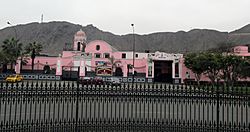Convent of Our Lady of the Angels facts for kids
| Convento de Nuestra Señora de los Ángeles | |
 |
|
| Monastery information | |
|---|---|
| Other names | Convento de los Descalzos |
| Order | Franciscan |
| Denomination | Catholic |
| Established | 1595 |
| Archdiocese | Archdiocese of Lima |
| Architecture | |
| Heritage designation | Cultural heritage of the Nation |
| Designated date | 1972 |
| Style | Spanish Colonial |
| Site | |
| Location | Lima |
| Country | Peru |
| Coordinates | 12°02′01″S 77°01′28″W / 12.0336°S 77.0245°W |
The Convent of Our Lady of the Angels (Spanish: Convento de Nuestra Señora de los Ángeles) is a special religious building in Rímac District, Lima, Peru. It's often called the Iglesia y Convento de los Descalzos, which means "Church and Convent of the Barefoot Ones." This important place was officially named a cultural heritage of Peru in 1972, meaning it's a valuable part of Peru's history and culture. It belongs to the Franciscan religious group.
Contents
A Look Back: The Convent's Story
How the Convent Began
The Convent of Our Lady of the Angels was started a long time ago, in 1595. It was founded by the Franciscan Order, a group of Catholic religious people. They built it on land given by María de Valera and her son, Luis Guillén. These people were very generous supporters of the Franciscan group.
The convent is located in the historic area of Rímac. It sits at the bottom of the San Cristóbal Hill. A beautiful walking path, called the Alameda de los Descalzos, leads right to the convent. This path was created in 1611 to make the journey to the convent easier and more pleasant. People in the area started calling it the "barefoot convent." This was because the Franciscans who lived there wore simple sandals, making them seem "barefoot."
The Convent's Design
The building has a simple and plain design. It doesn't have many fancy decorations. Inside, you'll find long hallways and rooms on different levels. This is because the convent was built on the side of a hill, which has a natural slope. Its building style looks a lot like an old country house or farm.
A Center for Learning and Faith
For many years, this Franciscan convent was a very important place. It served as a center for teaching Christian ideas. Missionaries, who are people sent to spread religious messages, would leave from here. They traveled to the Peruvian highlands to teach the local people about Christian beliefs.
The Museum of the Barefoot Ones
Today, part of the convent is a museum! On December 18, 1981, the Museo de los Descalzos (Museum of the Barefoot Ones) opened its doors. Inside, you can see many interesting things.
- Religious Items: The museum displays special items related to important religious figures. These include Francisco Solano, Francisco de Asís, and Antonio de Padua.
- Art Collection: There are more than 300 paintings in the museum. These artworks come from famous art schools in Cusco, Lima, and Quito.
- Old Books: The convent also has a huge library. It holds over 15,000 books! These books are very old, some dating back to the 16th century. They are special because they are bound in goatskin.
See also
 In Spanish: Iglesia y Convento de los Descalzos para niños
In Spanish: Iglesia y Convento de los Descalzos para niños

